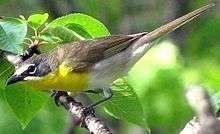Yellow-breasted chat
| Yellow-breasted chat | |
|---|---|
 | |
| Scientific classification | |
| Kingdom: | Animalia |
| Phylum: | Chordata |
| Class: | Aves |
| Order: | Passeriformes |
| Family: | Incertae sedis |
| Genus: | Icteria Vieillot, 1808 |
| Species: | I. virens |
| Binomial name | |
| Icteria virens (Linnaeus, 1758) | |
The yellow-breasted chat (Icteria virens) is a large songbird, widely considered the most atypical member of the New World warbler family, though the long-standing suspicion is that it does not actually belong there. Its placement is not definitely resolved. It is the only member of the genus Icteria.
Distribution and habitat
Found throughout North America, from southern-plains of Canada to central Mexico during the summer, these birds mainly migrate to Mexico and Central America, although some of their number may overwinter in coastal areas. This species occurs in areas where dense shrubby growth is common. Today, its habitat often consists of abandoned farmland and other rural areas where overgrown vegetation proliferates.
Description
If they are considered part of the family Parulidae (New World warblers), yellow-breasted chats are the largest species of parulid. In fact, they can often weigh more than twice as much as other parulid species. However, their membership in this taxonomic family is disputed.
This species reaches a total length of 17 to 19.1 cm (6.7 to 7.5 in) and a wingspan of 23 to 27 cm (9.1 to 10.6 in). Body mass can range from 20.2 to 33.8 g (0.71 to 1.19 oz). Among standard measurements, the wing chord is 7.1 to 8.4 cm (2.8 to 3.3 in), the elongated tail is 6.9 to 8.6 cm (2.7 to 3.4 in), the relatively long, heavy bill is 1.3 to 1.6 cm (0.51 to 0.63 in) and the tarsus is 2.5 to 3.1 cm (0.98 to 1.22 in).[2] These birds have olive upperparts with white bellies and bright yellow throats and breasts. Other signature features of yellow-breasted chats are its large white eye-rings and blackish legs. If seen, this species is unlikely to be mistaken for any other bird.
Biology
The yellow-breasted chat is a shy, skulking species of bird, often being only heard but not seen. The breeding habitats of this species are dense, brushy areas and hedgerows. The nests of these birds are bulky cups made of grasses, leaves, strips of bark, stems of weeds and lined with finer grasses, wiry plant stems, pine needles and sometimes roots and hair. Nests are invariably placed in thick shrubs and often only about 2.5 m (8.2 ft) above the ground. They will lay from 3 to 5 creamy white eggs with reddish brown blotches or speckles, incubated by the female, hatch in 11 to 12 days. Both parents tend the young, who fledge in approximately 8 to 11 days. Chats are apparently vigilant guards of their nests, as parasitism by brown-headed cowbirds is not as frequent as with other cup nest builders.[3] However, they are not as monogamous as other warblers. In one study in central Kentucky, DNA fingerprinting revealed that 17% of 29 yellow-breasted chat nestlings were not sired by the male of the social pair and 33% of 9 broods contained at least 1 extra-pair nestling.
Yellow-breasted chats are ominvorous birds, and forage in dense vegetation. Mostly, this species feeds on insects and berries, including blackberries and wild grapes. Insects of up to moderate sizes, including grasshoppers, bugs, beetles, weevils, bees, wasps, tent caterpillars, ants, moths and mayflies, are typically predated and will be gleaned from dense vegetation.[3] Other invertebrates, including spiders, are occasionally eaten as well. Uniquely for a passerine of its size, the chat occasionally grips food with its feet before it eats.
The song of this bird is an odd, variable mixture of cackles, clucks, whistles and hoots. Their calls are harsh chak's. Unlike most warblers, this species has been known to mimic the calls of other birds. Thus, less experienced field birdwatchers sometimes overlook chats after mistaking their song for species such as gray catbirds and brown thrashers, which share similar habitat preferences and skulking habits, though are generally much more abundant. During the breeding season, chats are at their most conspicuous as they will usually sing from exposed locations and even fly in the open while gurgling their songs.[4]
Status
Yellow-breasted chats are declining in eastern North America due to habitat loss, which is caused primarily from deforestation and urban development. This species, though less vulnerable than other cup-nesters, is still sometimes victim to brood parasitism from brown-headed cowbirds that have taken advantage of the fragmentation of Eastern forests to expand their range in the last century. However, the species still occurs over a wide range and is considered to be of least concern.[5]
References
- "Icteria virens". Integrated Taxonomic Information System. Retrieved 27 February 2006.
- Sibley, David Allen. The Sibley Field Guide to Birds of Western North America, ISBN 0-679-45121-8
- ↑ BirdLife International (2012). "Icteria virens". IUCN Red List of Threatened Species. Version 2013.2. International Union for Conservation of Nature. Retrieved 26 November 2013.
- ↑ Jon Curson, David Quinn and David Beadle. 1994. New World Warblers: An Identification Guide, ISBN 0-7136-3932-6.
- 1 2 Yellow-breasted Chat. Wbu.com. Retrieved on 2012-08-24.
- ↑ Yellow-breasted Chat, Life History, All About Birds – Cornell Lab of Ornithology. Allaboutbirds.org. Retrieved on 2012-08-24.
- ↑ Icteria virens (Yellow-breasted Chat). Iucnredlist.org. Retrieved on 2012-08-24.
External links
| Wikimedia Commons has media related to Icteria virens. |
- Yellow-breasted chat at AviBase
- Yellow-breasted chat at CT Department of Environmental Protection
- Yellow-breasted chat Species Account – Cornell Lab of Ornithology
- Yellow-breasted chat – USGS Patuxent Bird Identification InfoCenter
- Stamps (for Antigua and Barbuda)
- Yellow-breasted chat videos on the Internet Bird Collection
- Yellow-breasted chat photo gallery VIREO
- Yellow-breasted chat bird sound
